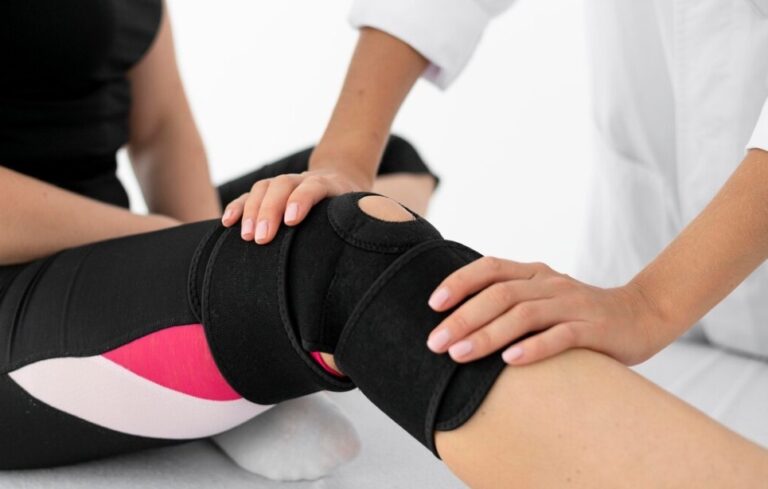I’ll admit it—I once thought electrical tape could fix anything. When a garden light wire started sparking after a summer storm, I grabbed my trusty roll of black tape, wrapped it tight, and proudly called it “problem solved.”
The next morning, the light flickered, fizzled, and died. That’s when I learned the hard truth about is electrical tape waterproof—it isn’t.
Electrical tape is handy, yes, but it’s not a magical waterproof shield. It can handle a splash or two, but long-term exposure to water? That’s where it fails miserably. Let me explain why, what you can safely use it for, and what to grab instead when moisture is part of the picture.
What Does It Mean When We Ask, “Is Electrical Tape Waterproof?”
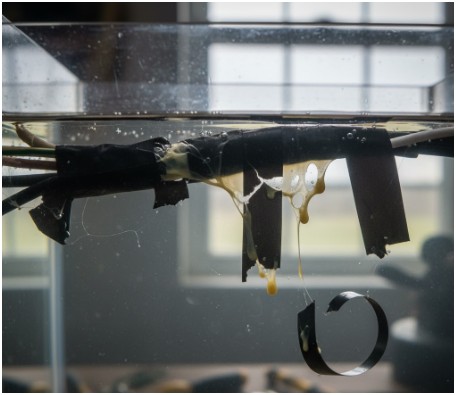
When people ask is electrical tape waterproof, they usually mean, “Can it survive rain, splashes, or a little water exposure?”
Standard electrical tape is water-resistant, not waterproof. It can endure light moisture for short periods, but the adhesive eventually breaks down under constant wetness.
Most electrical tapes use rubber-based adhesives that lose grip when exposed to water. The longer they stay wet, the weaker they get. That’s why outdoor repairs or underwater fixes wrapped in standard tape usually fail—sometimes dramatically.
If you’ve ever noticed your taped wire peeling or cracking after a few days outside, that’s exactly what’s happening: the adhesive is degrading, seams are opening, and moisture is sneaking in.
Why Does Electrical Tape Fail in Wet Conditions?
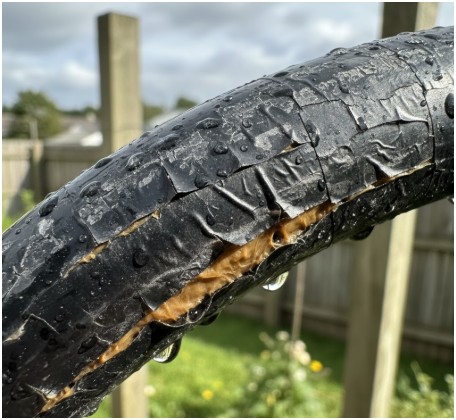
I learned that the problem isn’t just water—it’s the combination of pressure, temperature, and time. Even the best electrical tape struggles against those three forces.
Adhesive failure happens because rubber-based glue softens when exposed to humidity. Once it loses tack, it can’t hold the wrap tight anymore.
Add seam gaps, and you’ve got tiny channels where water can travel. Even if you layer it thick, water pressure can push through those overlaps, especially on curved or uneven surfaces.
And then there’s the outdoor factor—sunlight, UV rays, and temperature swings. These make the tape brittle and cracked.
That’s why that glossy black finish turns grayish and flaky after a few weeks outside. Electrical tape just isn’t built for outdoor waterproofing—it’s meant for insulation and temporary fixes.
So, What Should You Use Instead of Electrical Tape for Wet Areas?
If you need to protect wires in wet or submerged locations, it’s time to reach for the big-league materials. I’ve tried several, and these are the ones that actually do what electrical tape can’t.
| Waterproof Option | Best For | Key Benefit |
| Self-Fusing Silicone Tape | Outdoor splices, garden lights | Creates a seamless, adhesive-free rubber barrier |
| Heat-Shrink Tubing (with adhesive) | Wire joints, connectors | Shrinks tightly and seals moisture completely |
| Liquid Electrical Tape | Irregular or hard-to-reach areas | Forms a flexible, brush-on waterproof coating |
| Waterproof Connectors | Underground or outdoor wiring | Pre-sealed, gel-filled, and safe to code |
| High-Grade Rubber Tape (e.g., 3M) | Heavy-duty or high-voltage uses | Extremely moisture- and weather-resistant |
These products might cost a bit more upfront, but they’re designed for lasting protection. For example, self-fusing silicone tape doesn’t even use glue—it bonds to itself, creating a waterproof rubber sleeve that won’t unravel in the rain.
If you’re dealing with outdoor lighting or marine wiring, heat-shrink tubing is a lifesaver. When heated, it hugs the connection tight and seals out water completely, especially the adhesive-lined kind. For weird shapes or quick touch-ups, liquid electrical tape is my go-to—it’s like painting on waterproof armor.
Can You Use Electrical Tape Outdoors at All?
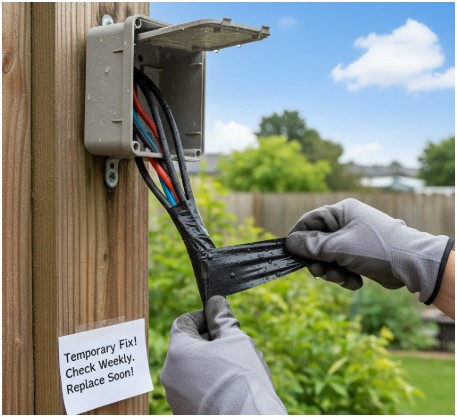
Yes—but only with caution. You can use electrical tape outdoors for temporary fixes, like wrapping exposed wire ends or securing a loose cable. Just remember, it’s not a long-term solution.
If you’re using it outside, keep these tips in mind:
- Wrap tightly with overlapping layers to minimize water entry.
- Cover the taped area with a protective casing if possible.
- Check it regularly, especially after heavy rain or temperature shifts.
Think of it like a Band-Aid, not a permanent patch. It’ll help for a bit, but you’ll need a proper repair soon.
How Can You Make Electrical Tape More Water-Resistant?
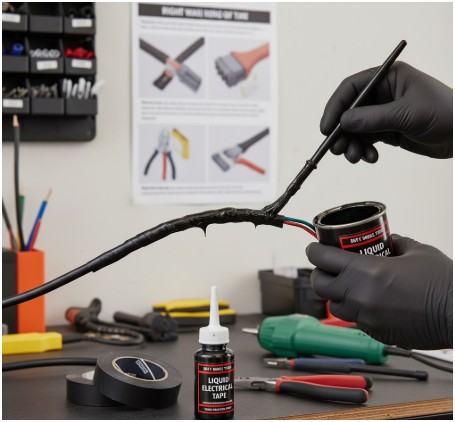
If you’re in a pinch, there are ways to boost your tape’s performance. First, make sure the surface is clean and dry before wrapping—dust and grease weaken adhesion.
Wrap in overlapping spirals, stretching slightly to create tension. Then, for added protection, layer silicone or mastic tape over it.
You can also apply a thin coat of liquid electrical tape on top for extra sealing. I once used that trick when fixing my boat’s deck light, and it held through the whole season. It’s not a UL-rated fix, but for short-term outdoor work, it’s a decent hack.
Still, for any permanent connection exposed to water, a proper waterproof connector or heat-shrink tubing is always safer and compliant with electrical standards.
What Do Safety Organizations Say About It?
According to Underwriters Laboratories (UL) and similar safety bodies, standard electrical tape should never be your only waterproofing method. It’s not rated for wet or submerged environments.
If you’re doing electrical work near water, you’re required to use waterproof-rated materials to avoid shock risks and code violations.
When in doubt, check the packaging. Products that are UL-listed for waterproof use will clearly say so. It’s always better to be safe than sorry when electricity and moisture mix.
FAQs About “Is Electrical Tape Waterproof?”
Q1. Can I use electrical tape to fix a leaking pipe?
No—you should never use electrical tape for plumbing. It can’t handle water pressure, and the adhesive will loosen quickly. Use silicone repair tape or plumbing-specific sealing solutions instead.
Q2. What happens if electrical tape gets wet?
If electrical tape gets wet, its adhesive starts to fail. Over time, it loses grip, peels off, and may let moisture reach live wires, creating potential shock or short-circuit hazards.
Q3. What’s the difference between waterproof and water-resistant electrical tape?
Water-resistant tape repels light moisture temporarily, while waterproof tape creates a true barrier against continuous water exposure. Standard electrical tape falls in the first category.
Q4. Can I use electrical tape for outdoor Christmas lights?
Yes, but only as a temporary measure. For a safe, long-term setup, use weatherproof connectors or heat-shrink tubing to seal the connections and keep water out.
The Shocking Truth (Literally): Don’t Rely on Regular Tape for Water Protection
When I first asked myself, “Is electrical tape waterproof?” I wanted a quick, cheap solution. But after a few failed experiments and one near-electrocution scare, I learned that the right materials matter.
Electrical tape is great for insulation, temporary fixes, and indoor projects—but when it comes to moisture, it’s no superhero. If water’s in the picture, switch to self-fusing silicone tape, heat-shrink tubing, or liquid electrical tape.
My rule now? When in doubt, waterproof it properly the first time. Trust me—it’s way better than getting shocked twice.






